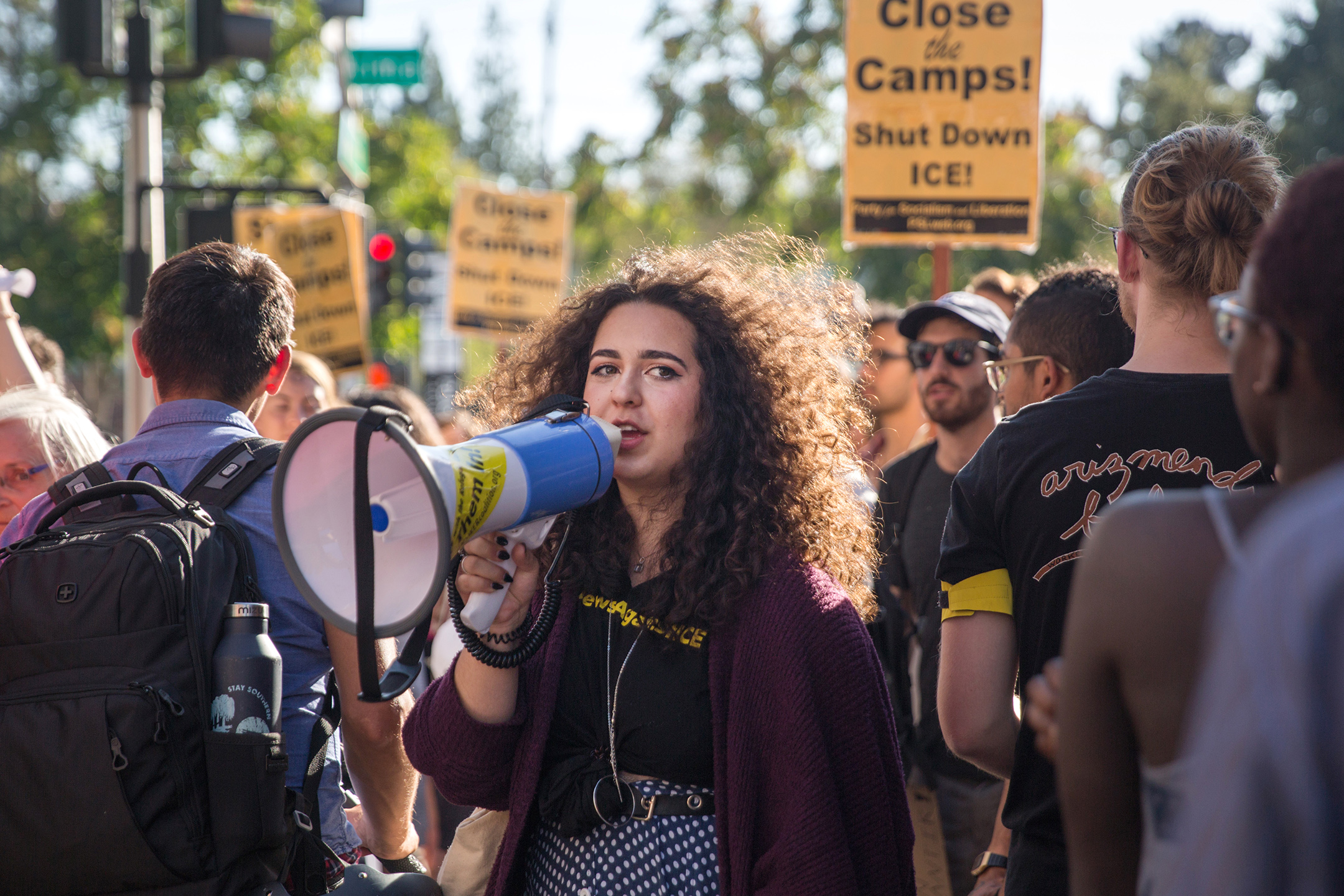This article appears in VICE Magazine's 2019 Profiles Issue. This edition looks to the future by zeroing in on the underrecognized writers, scientists, musicians, critics, and more that will shape our world next year. They are "the Other 2020" to watch. Click HERE to subscribe to the print edition.
On September 13 more than a hundred activists participated in a bicoastal protest at Palantir’s two headquarters, in New York City and in Palo Alto, California. The intent of the protest was to bring awareness to the tech company’s involvement with Immigration and Customs Enforcement (ICE), which Palantir provides with data-mining software that’s been used to screen undocumented immigrants and plan raids.
While the events put pressure on such Palantir higher-ups as the CEO, Alex Karp, and its co-founder Peter Thiel, the billionaire investor and Donald Trump ally, the messaging was geared to Palantir workers themselves. At the Palo Alto action, concentration camp–style barbed wire fencing was placed outside the company’s offices, and then an afternoon rally was held in front of one of Karp’s houses. “Palantir, you know it’s true / The crimes of ICE depend on you,” chanted marchers. The Manhattan action, led by the group Jews for Economic and Racial Justice, called on Karp, who is Jewish, to honor the approaching high holidays by not repeating mistakes of the past.
“During the Holocaust, IBM used the latest technology to aggregate census information, which was used to identify Jews around Europe,” said Abby Stein, one of the organizers, to the crowd. “What if the workers at IBM had said no? How many lives would have been saved? What if the workers at Palantir say no now? How many families would be kept whole?”
You could say these actions were at the end of a timeline that began a week prior, when Karp wrote an op-ed in the Washington Post explaining his decision to continue working with ICE. Or you could wind the clock back a few weeks farther, to when Palantir officially renewed its contract with ICE. Or before that, when the photo of the bodies of Óscar Alberto Martínez and his 23-month-old daughter, Valeria, who’d both washed up on the banks of the Rio Grande after a failed border crossing attempt, went viral.
But you could also look farther back, or even beyond Palantir’s partnership with ICE, at a slowly layering movement, in which each siloed group of workers watches every new protest action and wonders, “If them, why not us?”
There was the great Uber and Lyft strike of 2019, when drivers around the world turned off their apps for 24 hours. And the Google walkout of late 2018, when more than 20,000 Google employees left work to protest sexual harassment within the company. And, earlier that year, the series of actions at Twitter and Stripe HQs after their CEOs funded a campaign countering Prop C, a San Francisco measure levying a small tax on huge corporations in order to pay for homeless services within the city. (The measure passed, albeit without the two-thirds supermajority needed to keep it from delays via legal challenges.)

As with the public school wildcat strikes that rolled through the United States in 2018, each action has seemed to lead to the next as workers at all levels watch tech’s tendrils wind through nearly every sector of work and wreak consequences: Disruption often leads to dysfunction, the profits of innovation don’t trickle down, and technology brings the world together while it tears families apart.
As these truths become more blatant, a diverse group of workers—programmers and coders, drivers and cafeteria staff—are beginning to bond as a sort of cohesive class. If they get there, it’ll finally force tech to do what it’s been claiming it does all along: make the world a better place.
While there have been efforts to organize and mobilize tech workers for years, the broadest radicalizing force is the most obvious one: the presidency of Donald Trump.
“A lot of things happened before, but Trump catalyzed a lot of activity within the industry,” said Jeffrey Buchanan, a spokesperson for Silicon Valley Rising, a coalition of labor leaders and community organizers.
The key moment wasn’t necessarily Election Night, when everyone was still in a state of shock and confusion, but rather a few weeks after that, in late 2016, when the future president met with tech’s biggest CEOs. That moment, workers have told me, was when they realized their bosses would compromise with, rather than fight against, the incoming administration. The years since have proved this analysis correct—in 2017, Google began building out the Pentagon’s artificial intelligence program under Project Maven, while more recently, Microsoft won the contract to handle their cloud computing.
“I’m not the savviest tech person—people make fun of me because I can’t even figure out Facebook,” said Jacinta Gonzalez, the field director for Mijente, a grassroots hub for Latinx and Chicanx organizing—they helped organize the Palantir actions. “But we’re interested in it now because it’s affecting our communities.”
Gonzalez explained that as ICE raids have increased, Mijente has begun fielding questions about technology’s expanding role with things like data mining, GPS location, and facial recognition software. “All of that is going to be used in the next stage of racial incarceration in the U.S.,” Gonzalez said. “There was a lot of hype and excitement about how technology was going to bring us closer together, but we’re starting to see the negative consequences. It brings up a bunch of ethical questions for people who are affected by it, and also for tech workers themselves.”

This self-examination seems new to the tech industry. Tech ideology has always trended in the direction of achieving broadly socially liberal aims through crypto-libertarian means—working toward an “open” society through “disruption.” In practice, this has largely translated into replicating previous experiences, but more quickly and without worker protections, exploiting gaps in a regulatory state that moves too slowly. The tech-optimist view that has dominated has been based on a sort of vulgar reading of the efficient-markets hypothesis, the idea that efficiency is not just desirable in itself but will definitionally lead to good ends, so that creating more tools to that end is a worthy aim. But what that has missed is how efficiency’s inherent result is more wealth and power trickling up to ownership, and how making more productive tools means further draining the disenfranchised.
As time reveals these truths, workers project the trend lines and see a bleak future. Unless they stop it in time.
Edan Alva is a 49-year-old tech worker. Originally from Israel, he’s been in the United States for the past 19 years, working as a contract freelancer for financial institutions, schools, and other tech companies. A few years back, he downloaded Lyft as a little side gig to get some extra money picking up passengers as he drove to and from work. But when he got terminated from his steady gigs, he turned to driving full-time, and it changed his perspective.
“Pay went down significantly, and meanwhile, you’re paying more to service the car,” he explained. “Most drivers don’t notice they’re losing money instead of earning it because those costs are spread over time.” Further shifting him into action was seeing firsthand how wide the gap was between the lifestyles of the rich and how the drivers themselves lived. “You find very quickly that you can barely make a living in the Bay Area, and it causes resentment, especially when the CEOs are making $45 million a year,” he said.
Alva heard about the organizing coalition Gig Workers Rising (GWR)—a group largely composed of Uber and Lyft drivers fighting for a living wage and benefits, transparency, and a voice at the workplace—and decided to join. Part of it is fighting for a better life now. “I enjoy talking with people and having unique situations that occur,” he said, when I asked him why he still drives. “But that has nothing to do with the company of Lyft.”
While some of his involvement with GWR is to fight for better conditions in his current job, he’s also thinking about his next gig, whatever that may be. It’s impossible to look at the trajectory of technological advancements and see much in the way of future work that will remain. Algorithms will be doing copywriting, self-driving technology will be handling cabs and trucks, and robot servers and bartenders are coming soon enough. “Any industry can be put in an app,” he said. “Companies like Lyft and Uber deeply reflect the fact that people who happen to be in particular positions get extremely wealthy at the expense of workers, and sometimes even the expense of their investors. It almost sounds like a pyramid scheme.”

One fight that’s been won—albeit with legal battles still left to wage, the result of trying to regulate a well-armed industry that hates following laws—is the passage of AB-5 in the California state legislature, which would ensure that gig economy workers for companies like Uber and Lyft are categorized as employees, rather than 1099 contractors. (GWR was one of the main forces behind moving this legislation forward.) This would mean drivers would get minimum wage, workers’ compensation, and other benefits. It would completely upend this industry, forcing companies to finally support their workers in a way they haven’t before.
“No one wants to think about it when you’re out on the road. It’s a reality you put in the back of your mind as much as you can,” said Carlos Ramos, who’s been driving for Lyft for the past three years and is also a member of GWR. “But if something were to happen out there, you’re all on your own.”
While Ramos is excited about the changes AB-5 could bring, he’s skeptical about the ability of tech workers of all ilks to form a mass counterforce to the way tech is currently run. “There’s a huge difference between who we are and who they are,” he said, recalling the many times he’s driven rich programmers through hilly San Francisco. “They’re wealthy, we aren’t. They have Michelin-star chefs in their offices and like to brag about it; we’re lucky if we can catch a Jack in the Box. They’re worried about the cost of living in multimillion dollar houses, and we’re sleeping in our cars.” If there is to be a seismic shift in how the tech industry works, this difference in pay and privilege between workers at, say, Palantir and drivers at Uber needs to be flattened.
But there is also an often-overlooked spectrum of tech worker that exists between high-wage programmers at massive companies and gig workers used as chum. It’s a segment that may become more common as tech continues to infiltrate every crevice of society, and perhaps where the next wave of organizing will take place.
“There’s a huge difference between who we are and who they are,” Carlos Ramos said. “They’re wealthy, we aren’t... They’re worried about the cost of living in multimillion dollar houses, and we’re sleeping in our cars.”
One tech worker named Eric—whose name has been changed to protect his identity and prevent professional ramifications—has been working in the field for almost 15 years. He’s now at what he considers a “pretty standard start-up,” and while things have been going well, their tech side was just split off by the parent company, a move that has employees asking questions. “How much has this technology made the world a better place?” Eric asked. “I can see it as the way I’m making money, but it’s not actually improving anything.”
After years of hope in what tech can do, Eric now sees the industry in “this ridiculous cycle” of investment bankers and venture capitalists building unnecessary “disruptions” on the off chance they’ll make investors more money, but paying no real attention to worker stability, let alone worrying about actually helping the world. Now, with a new management structure coming in, the future of his job seems murkier—who knows what change will bring, or if he’ll want to stick around for it. To combat this, Eric is turning back to really the only way to counter the power imbalance between owners and workers: “We don’t have input in how the organization relates to us, so the only recourse we have is to quit, unless we work to collectively bargain,” he explained. “So I’m now starting efforts to unionize.”
Look around and you sense that this shift from tech optimism to tech skepticism (or maybe tech realism) is trickling down to the next generation of workers. As further reports showing the impact these massive companies have had on society come to light, the signing bonuses and Ping-Pong tables in the open-plan offices may not be enough to justify taking these jobs. But with the Trump administration being such a galvanizing force, and an approaching election perhaps scooting him from office, will this trend continue no matter what?
“As a millennial myself, aside people who’ve been fucked by the economy and by the previous generation, I’d be surprised if we went back to where we were in 2016,” said Catherine Bracy, the director of the advocacy organization TechEquity Collaborative. “If you’re a 25-year-old tech worker who has $60,000 in student loan debt at 8 percent interest, who never has a chance in hell of buying a house close to your job, and you’re living with three roommates until you’re 35, you’re asking questions about what this economy has gotten you.”
A new student movement called SLAP, Students for the Liberation of All People, has been urging computer science students from Stanford to forgo jobs at massive tech firms like Google and Facebook. “We are an anti-racist, anti-capitalist organization fighting to mobilize students to recognize and act on our responsibility to support liberation movements,” reads SLAP’s mission statement. “Through direct action, education, and community-building, we aim to disrupt the culture of apathy that upholds an oppressive status quo, envision alternatives, and sustainably campaign for tangible wins in partnership with marginalized people. We struggle against worker exploitation, the prison industrial complex, and the systemic violence that Stanford perpetuates and profits from.” In September, more than 1,200 students from 17 colleges pledged not to work for Palantir.
This is new in how graduates view what defines a “good” tech job, and it suggests that while Trump may have been an accelerant to the movement, the fire won’t be extinguished by something as neat and clean as the result of a single election in 2020.
from VICE https://ift.tt/34aosEA
via cheap web hosting
No comments:
Post a Comment